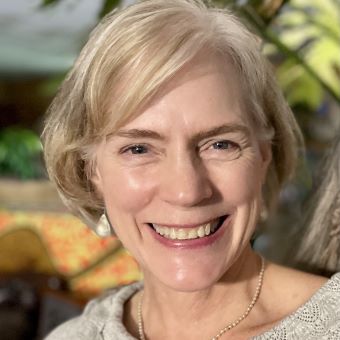This Spotlight is contributed by Language, Culture and Justice Hub coordinator Leigh Swigart.
It has become a commonplace to characterize English as the language of globalization, the contemporary sine qua non of international business, international education (see Rosemary Salomone’s May 2024 Spotlight), international law (see Leigh Swigart’s December 2022 Spotlight), international diplomacy, and more. English is now spoken by many more persons around the world as a second (third, fourth…) language (between 1.5 and 2 billion speakers) than as a first language (400 million speakers). English is what scholars Ingrid Piller and Alexandra Grey describe as the “hyper-central language of globalization,” the apex of a linguistic pyramid where most languages cluster at the bottom, with increasingly centralized languages at national and regional levels filling the upper spots underneath English.
But what kind of English resides at the apex of this pyramid? The reality is that many types of English – diverse dialects, varieties, and English-based contact languages – are not considered proper vehicles of globalization. And some are at risk of becoming irrelevant or even extinct in the 21st century.
English as an international lingua franca, or “World English,” needs to be distinguished from what have been called “World Englishes,” localized forms of English spoken around the globe, especially varieties that have developed in territories influenced by the United Kingdom or the United States. In the 1980’s, Indian linguist Braj Kachru formulated a model whereby Englishes are categorized into three concentric circles. As explained by Mohammad A. Al-Mutairi:

“The Inner Circle presents the countries where English is used as a native language and as a first language among people. These countries include the USA, the UK, Canada, Australia, and New Zealand. The Outer Circle includes countries that have old historical British colonial relations and where English is commonly used in social life or the government sectors. Most of the countries that belong to this circle are former colonies of the British Empire, such as India, Malaysia, Singapore, Ghana, Kenya, and others. The usage of English in these countries is similar to what is known as English as a second language. The third circle, The Expanding Circle, includes countries that introduce English as a foreign language in schools and universities, mostly for communicating in English with the Inner and Outer Circles. Such countries include Turkey, Saudi Arabia, The Emirates, Japan, China, Korea, and others.”
Kachru’s model, while highly influential, is now seen as perhaps oversimplified. And since the model’s formulation, English has become increasingly entrenched around the world as the dominant mode of communication in many spheres of activity, including on the Internet. The use of English in the digital world crosses national boundaries and unifies disparate populations in ways that would have been difficult to imagine in the 1980’s.
The principal question posed in this commentary is the following: what is the position of the Englishes spoken in the Outer and Expanding Circles in the contemporary linguistic landscape? How are varieties that emerged in countries and regions historically touched by English-speaking populations – often in contexts of colonial subjugation – faring in today’s world?
It has been documented that persons from Outer Circle or Expanding Circle countries who settle or pursue studies in Inner Circle countries often find that their varieties of English are devalued or considered deficient. This was a finding of a study at Brandeis University in the United States, where international students from South Asia, Africa and elsewhere ran up against accent and dialect discrimination. It was also found that students from particular English-speaking countries – mostly in Africa or South Asia – are required to pass proficiency exams as part of their application process while students from English-speaking countries with majority white populations are not. Even nationals of Northern European countries without an English-speaking tradition are frequently exempted from proficiency testing. Agnes Bodis and Ingrid Piller document the same phenomenon in Australian higher education, describing a distinction between what they term “inherent English” and “tested English.” They note that “[i]herent English maps most closely on the identity of the white native-speaker citizen construct.”
The relatively new field of raciolinguistics explores this pattern, examining how language is used to construct race and how ideas of race influence language use and attitudes, especially in relation to racialized subjects. Vijay Ramjattan (see December 2019 Spotlight) has studied how non-white ESL instructors in Canada are deemed less desirable than their white counterparts, even if the latter have a non-Canadian accent. In Mingyi Li’s research (see November 2022 Spotlight, she found that asking Chinese students to imitate North American and British accents “formed a colonized mentality within the language classroom. It divided students into accent hierarchies based on the level that they could speak the so-called standard English.”
The varieties of English that are valued, in other words, are those spoken in the core of “the Anglosphere” – North America, the UK, Australia and New Zealand – where the majority populations are of European descent.
 English-based contact languages – pidgins, creoles and mixed languages – comprise another category of language that suffers from bias, misunderstanding and lack of promotion. Such languages resulted from a need for communication between diverse populations, some coming together in contexts of peaceful trade but also, all too often, in contexts of violence and oppression. These “linguistic mash-ups” embody the distinctive history of the places where they are spoken, their grammars and lexicons echoing the voices of those who together shaped the societies, cultures and lives of their contemporary speakers. Many contact languages are spoken by the majority of a country’s population while remaining largely unwritten and without official or governmental support. Examples are Krio in Sierra Leone and Patois (Patwa) in Jamaica. Such creolized varieties still tend to be heard as “broken English” and their integrity as full languages misunderstood. Jamaican linguist Joseph Farquharson, an advocate for the promotion of Patois, served as a consultant for the recent Bob Marley biopic “One Love,” but only on the condition that the script be faithful to Patois grammar and syntax instead of using inaccurate and caricaturized speech. (Readers may learn more about Dr. Farquharson’s work through his contribution to a February 2024 Hub webinar on The Impact of Global English in Higher Education and Beyond).
English-based contact languages – pidgins, creoles and mixed languages – comprise another category of language that suffers from bias, misunderstanding and lack of promotion. Such languages resulted from a need for communication between diverse populations, some coming together in contexts of peaceful trade but also, all too often, in contexts of violence and oppression. These “linguistic mash-ups” embody the distinctive history of the places where they are spoken, their grammars and lexicons echoing the voices of those who together shaped the societies, cultures and lives of their contemporary speakers. Many contact languages are spoken by the majority of a country’s population while remaining largely unwritten and without official or governmental support. Examples are Krio in Sierra Leone and Patois (Patwa) in Jamaica. Such creolized varieties still tend to be heard as “broken English” and their integrity as full languages misunderstood. Jamaican linguist Joseph Farquharson, an advocate for the promotion of Patois, served as a consultant for the recent Bob Marley biopic “One Love,” but only on the condition that the script be faithful to Patois grammar and syntax instead of using inaccurate and caricaturized speech. (Readers may learn more about Dr. Farquharson’s work through his contribution to a February 2024 Hub webinar on The Impact of Global English in Higher Education and Beyond).
Some English-based contact languages, like Gullah, find themselves at risk of extinction. The Gullah people are descendants of various African ethnic groups who were forced together on South Carolina plantations. “When Ashantis, Fantes, Fulas, Ibos, Mandingos, Yorubas, the Bakongo cultures, and other peoples arrived as slaves in America, they established a creole language—Gullah—from English and African sources.” Speakers of Gullah are now mostly elderly, living on a few islands along the Atlantic coast of South Carolina. Many other contact languages around the globe find themselves in the same vulnerable situation as Gullah.
The next time we hear someone bemoan the dominance of the English language across the globe, we should remind ourselves that English comes in many forms and varieties, not all of them currently thriving or even considered valid.
